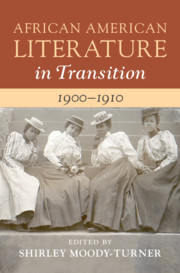Book contents
- African American Literature in Transition, 1900–1910
- African American Literature in Transition
- African American Literature in Transition, 1900–1910
- Copyright page
- Contents
- Figures
- Contributors
- Preface
- Acknowledgments
- Chronology, 1900–1910
- Introduction
- Part I Transitions in African American Authorship, Publishing, and the Visual Arts
- Part II New Negro Aesthetics and Transitions in Genre and Form
- Chapter 4 African American Novels and the New Slavery in the New South
- Chapter 5 Anti-Lynching Poetry and the Poetics of Protest
- Chapter 6 The Politics of Performance, Character, and Literary Genre in Transition
- Part III Modernist Masculinities and Transitions in Black Leadership
- Part IV Remapping the Turn of the Twentieth Century
- Index
Chapter 4 - African American Novels and the New Slavery in the New South
from Part II - New Negro Aesthetics and Transitions in Genre and Form
Published online by Cambridge University Press: 29 April 2021
- African American Literature in Transition, 1900–1910
- African American Literature in Transition
- African American Literature in Transition, 1900–1910
- Copyright page
- Contents
- Figures
- Contributors
- Preface
- Acknowledgments
- Chronology, 1900–1910
- Introduction
- Part I Transitions in African American Authorship, Publishing, and the Visual Arts
- Part II New Negro Aesthetics and Transitions in Genre and Form
- Chapter 4 African American Novels and the New Slavery in the New South
- Chapter 5 Anti-Lynching Poetry and the Poetics of Protest
- Chapter 6 The Politics of Performance, Character, and Literary Genre in Transition
- Part III Modernist Masculinities and Transitions in Black Leadership
- Part IV Remapping the Turn of the Twentieth Century
- Index
Summary
In 1905, at the height of both Jim Crow segregation and the Progressive era, Sutton E. Griggs and Charles W. Chesnutt published two complex and experimental novels that explored the “new slavery” that dominated in the New South. In The Hindered Hand and The Colonel’s Dream Griggs and Chesnutt, respectively, evoked literary tropes and narrative strategies connected with the representation of slavery. At the same time, through revisionary intertextuality, irony, and experimentation with the temporal construction of narrative form, they defamiliarized such tropes and strategies, in order to instantiate awareness-raising meta-narrative mechanisms that required the active critical involvement of readers in the process of interpretation, as would become characteristic of modernism and the Harlem Renaissance. Griggs’s and Chesnutt’s ability to take at a deeper level the portrayal of their segregationist times influenced contemporaneous mainstream representational politics with a force that is yet to be fully estimated, as can be gauged by the defensiveness that underlies Thomas Dixon’s attempt at the appropriation and racist misreading of African American literature and culture in his own fiction.
Keywords
- Type
- Chapter
- Information
- African American Literature in Transition, 1900–1910 , pp. 99 - 123Publisher: Cambridge University PressPrint publication year: 2021

